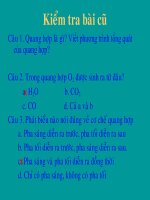Campellp12 Chu ky te bao
Bạn đang xem bản rút gọn của tài liệu. Xem và tải ngay bản đầy đủ của tài liệu tại đây (6.52 MB, 82 trang )
<span class='text_page_counter'>(1)</span>Chapter 12. The Cell Cycle. PowerPoint® Lecture Presentations for. Biology Eighth Edition Neil Campbell and Jane Reece Lectures by Chris Romero, updated by Erin Barley with contributions from Joan Sharp Copyright © 2008 Pearson Education, Inc., publishing as Pearson Benjamin Cummings.
<span class='text_page_counter'>(2)</span> Overview: The Key Roles of Cell Division • The ability of organisms to reproduce best distinguishes living things from nonliving matter • The continuity of life is based on the reproduction of cells, or cell division. Copyright © 2008 Pearson Education, Inc., publishing as Pearson Benjamin Cummings.
<span class='text_page_counter'>(3)</span> Fig. 12-1.
<span class='text_page_counter'>(4)</span> • In unicellular organisms, division of one cell reproduces the entire organism • Multicellular organisms depend on cell division for: – Development from a fertilized cell – Growth – Repair. • Cell division is an integral part of the cell cycle, the life of a cell from formation to its own division Copyright © 2008 Pearson Education, Inc., publishing as Pearson Benjamin Cummings.
<span class='text_page_counter'>(5)</span> Fig. 12-2. 100 µm. (a) Reproduction. 20 µm. 200 µm. (b) Growth and development. (c) Tissue renewal.
<span class='text_page_counter'>(6)</span> Fig. 12-2a. 100 µm. (a) Reproduction.
<span class='text_page_counter'>(7)</span> Fig. 12-2b. 200 µm. (b) Growth and development.
<span class='text_page_counter'>(8)</span> Fig. 12-2c. 20 µm. (c) Tissue renewal.
<span class='text_page_counter'>(9)</span> Concept 12.1: Cell division results in genetically identical daughter cells • Most cell division results in daughter cells with identical genetic information, DNA • A special type of division produces nonidentical daughter cells (gametes, or sperm and egg cells). Copyright © 2008 Pearson Education, Inc., publishing as Pearson Benjamin Cummings.
<span class='text_page_counter'>(10)</span> Cellular Organization of the Genetic Material • All the DNA in a cell constitutes the cell’s genome • A genome can consist of a single DNA molecule (common in prokaryotic cells) or a number of DNA molecules (common in eukaryotic cells) • DNA molecules in a cell are packaged into chromosomes. Copyright © 2008 Pearson Education, Inc., publishing as Pearson Benjamin Cummings.
<span class='text_page_counter'>(11)</span> Fig. 12-3. 20 µm.
<span class='text_page_counter'>(12)</span> • Every eukaryotic species has a characteristic number of chromosomes in each cell nucleus • Somatic cells (nonreproductive cells) have two sets of chromosomes • Gametes (reproductive cells: sperm and eggs) have half as many chromosomes as somatic cells • Eukaryotic chromosomes consist of chromatin, a complex of DNA and protein that condenses during cell division Copyright © 2008 Pearson Education, Inc., publishing as Pearson Benjamin Cummings.
<span class='text_page_counter'>(13)</span> Distribution of Chromosomes During Eukaryotic Cell Division • In preparation for cell division, DNA is replicated and the chromosomes condense • Each duplicated chromosome has two sister chromatids, which separate during cell division • The centromere is the narrow “waist” of the duplicated chromosome, where the two chromatids are most closely attached. Copyright © 2008 Pearson Education, Inc., publishing as Pearson Benjamin Cummings.
<span class='text_page_counter'>(14)</span> Fig. 12-4. 0.5 µm. Chromosomes. Chromosome arm. Centromere. DNA molecules. Chromosome duplication (including DNA synthesis). Sister chromatids. Separation of sister chromatids Centromere. Sister chromatids.
<span class='text_page_counter'>(15)</span> • Eukaryotic cell division consists of: – Mitosis, the division of the nucleus – Cytokinesis, the division of the cytoplasm. • Gametes are produced by a variation of cell division called meiosis • Meiosis yields nonidentical daughter cells that have only one set of chromosomes, half as many as the parent cell Copyright © 2008 Pearson Education, Inc., publishing as Pearson Benjamin Cummings.
<span class='text_page_counter'>(16)</span> Concept 12.2: The mitotic phase alternates with interphase in the cell cycle • In 1882, the German anatomist Walther Flemming developed dyes to observe chromosomes during mitosis and cytokinesis. Copyright © 2008 Pearson Education, Inc., publishing as Pearson Benjamin Cummings.
<span class='text_page_counter'>(17)</span> Phases of the Cell Cycle • The cell cycle consists of – Mitotic (M) phase (mitosis and cytokinesis) – Interphase (cell growth and copying of chromosomes in preparation for cell division). Copyright © 2008 Pearson Education, Inc., publishing as Pearson Benjamin Cummings.
<span class='text_page_counter'>(18)</span> • Interphase (about 90% of the cell cycle) can be divided into subphases: – G1 phase (“first gap”) – S phase (“synthesis”) – G2 phase (“second gap”). • The cell grows during all three phases, but chromosomes are duplicated only during the S phase. Copyright © 2008 Pearson Education, Inc., publishing as Pearson Benjamin Cummings.
<span class='text_page_counter'>(19)</span> Fig. 12-5. S (DNA synthesis). G1. M ito si s. in k to y C. is s e. MIT (M) OTIC PHA SE. G2.
<span class='text_page_counter'>(20)</span> • Mitosis is conventionally divided into five phases: – Prophase – Prometaphase. – Metaphase – Anaphase – Telophase. • Cytokinesis is well underway by late telophase BioFlix: Mitosis Copyright © 2008 Pearson Education, Inc., publishing as Pearson Benjamin Cummings.
<span class='text_page_counter'>(21)</span> Fig. 12-6. G2 of Interphase Centrosomes Chromatin (with centriole (duplicated) pairs). Prophase Early mitotic Aster Centromere spindle. Nucleolus Nuclear Plasma envelope membrane. Chromosome, consisting of two sister chromatids. Metaphase. Prometaphase Fragments Nonkinetochore of nuclear microtubules envelope. Kinetochore. Kinetochore microtubule. Anaphase. Cleavage furrow. Metaphase plate. Spindle. Centrosome at one spindle pole. Telophase and Cytokinesis. Daughter chromosomes. Nuclear envelope forming. Nucleolus forming.
<span class='text_page_counter'>(22)</span> Fig. 12-6a. G2 of Interphase. Prophase. Prometaphase.
<span class='text_page_counter'>(23)</span> Fig. 12-6b. G2 of Interphase Chromatin Centrosomes (with centriole (duplicated) pairs). Prophase Early mitotic Aster spindle. Nucleolus Nuclear Plasma envelope membrane. Prometaphase Centromere. Chromosome, consisting of two sister chromatids. Fragments of nuclear envelope. Kinetochore. Nonkinetochore microtubules. Kinetochore microtubule.
<span class='text_page_counter'>(24)</span> Fig. 12-6c. Metaphase. Anaphase. Telophase and Cytokinesis.
<span class='text_page_counter'>(25)</span> Fig. 12-6d. Metaphase. Anaphase. Metaphase plate. Spindle. Centrosome at one spindle pole. Telophase and Cytokinesis Cleavage furrow. Daughter chromosomes. Nuclear envelope forming. Nucleolus forming.
<span class='text_page_counter'>(26)</span> The Mitotic Spindle: A Closer Look • The mitotic spindle is an apparatus of microtubules that controls chromosome movement during mitosis • During prophase, assembly of spindle microtubules begins in the centrosome, the microtubule organizing center • The centrosome replicates, forming two centrosomes that migrate to opposite ends of the cell, as spindle microtubules grow out from them Copyright © 2008 Pearson Education, Inc., publishing as Pearson Benjamin Cummings.
<span class='text_page_counter'>(27)</span> • An aster (a radial array of short microtubules) extends from each centrosome • The spindle includes the centrosomes, the spindle microtubules, and the asters. Copyright © 2008 Pearson Education, Inc., publishing as Pearson Benjamin Cummings.
<span class='text_page_counter'>(28)</span> • During prometaphase, some spindle microtubules attach to the kinetochores of chromosomes and begin to move the chromosomes • At metaphase, the chromosomes are all lined up at the metaphase plate, the midway point between the spindle’s two poles. Copyright © 2008 Pearson Education, Inc., publishing as Pearson Benjamin Cummings.
<span class='text_page_counter'>(29)</span> Fig. 12-7. Aster Centrosome Sister chromatids. Microtubules. Chromosomes. Metaphase plate. Kinetochores. Centrosome. 1 µm Overlapping nonkinetochore microtubules. Kinetochore microtubules. 0.5 µm.
<span class='text_page_counter'>(30)</span> • In anaphase, sister chromatids separate and move along the kinetochore microtubules toward opposite ends of the cell • The microtubules shorten by depolymerizing at their kinetochore ends. Copyright © 2008 Pearson Education, Inc., publishing as Pearson Benjamin Cummings.
<span class='text_page_counter'>(31)</span> Fig. 12-8. EXPERIMENT Kinetochore Spindle pole. Mark. RESULTS. CONCLUSION Chromosome movement Motor Microtubule protein Chromosome. Kinetochore Tubulin subunits.
<span class='text_page_counter'>(32)</span> Fig. 12-8a. EXPERIMENT Kinetochore Spindle pole. Mark. RESULTS.
<span class='text_page_counter'>(33)</span> Fig. 12-8b. CONCLUSION. Chromosome movement. Microtubule. Motor protein Chromosome. Kinetochore Tubulin Subunits.
<span class='text_page_counter'>(34)</span> • Nonkinetochore microtubules from opposite poles overlap and push against each other, elongating the cell • In telophase, genetically identical daughter nuclei form at opposite ends of the cell. Copyright © 2008 Pearson Education, Inc., publishing as Pearson Benjamin Cummings.
<span class='text_page_counter'>(35)</span> Cytokinesis: A Closer Look • In animal cells, cytokinesis occurs by a process known as cleavage, forming a cleavage furrow • In plant cells, a cell plate forms during cytokinesis. Animation: Cytokinesis Copyright © 2008 Pearson Education, Inc., publishing as Pearson Benjamin Cummings.
<span class='text_page_counter'>(36)</span> Video: Animal Mitosis Video: Sea Urchin (Time Lapse). Copyright © 2008 Pearson Education, Inc., publishing as Pearson Benjamin Cummings.
<span class='text_page_counter'>(37)</span> Fig. 12-9. 100 µm. Cleavage furrow. Contractile ring of microfilaments. Vesicles forming cell plate. Wall of parent cell Cell plate. 1 µm New cell wall. Daughter cells. (a) Cleavage of an animal cell (SEM). Daughter cells (b) Cell plate formation in a plant cell (TEM).
<span class='text_page_counter'>(38)</span> Fig. 12-9a. 100 µm. Cleavage furrow. Contractile ring of microfilaments. Daughter cells. (a) Cleavage of an animal cell (SEM).
<span class='text_page_counter'>(39)</span> Fig. 12-9b. Vesicles forming cell plate. Wall of parent cell Cell plate. 1 µm New cell wall. Daughter cells (b) Cell plate formation in a plant cell (TEM).
<span class='text_page_counter'>(40)</span> Fig. 12-10. Nucleus Nucleolus. 1 Prophase. Chromatin condensing. Chromosomes. 2 Prometaphase. 3 Metaphase. Cell plate. 4 Anaphase. 5 Telophase. 10 µm.
<span class='text_page_counter'>(41)</span> Fig. 12-10a. Nucleus Nucleolus. 1 Prophase. Chromatin condensing.
<span class='text_page_counter'>(42)</span> Fig. 12-10b. Chromosomes. 2 Prometaphase.
<span class='text_page_counter'>(43)</span> Fig. 12-10c. 3 Metaphase.
<span class='text_page_counter'>(44)</span> Fig. 12-10d. 4 Anaphase.
<span class='text_page_counter'>(45)</span> Fig. 12-10e. Cell plate. 5 Telophase. 10 µm.
<span class='text_page_counter'>(46)</span> Binary Fission • Prokaryotes (bacteria and archaea) reproduce by a type of cell division called binary fission • In binary fission, the chromosome replicates (beginning at the origin of replication), and the two daughter chromosomes actively move apart. Copyright © 2008 Pearson Education, Inc., publishing as Pearson Benjamin Cummings.
<span class='text_page_counter'>(47)</span> Fig. 12-11-1. Origin of replication E. coli cell Two copies of origin. Cell wall Plasma membrane Bacterial chromosome.
<span class='text_page_counter'>(48)</span> Fig. 12-11-2. Origin of replication E. coli cell Two copies of origin. Origin. Cell wall Plasma membrane Bacterial chromosome. Origin.
<span class='text_page_counter'>(49)</span> Fig. 12-11-3. Origin of replication E. coli cell Two copies of origin. Origin. Cell wall Plasma membrane Bacterial chromosome. Origin.
<span class='text_page_counter'>(50)</span> Fig. 12-11-4. Origin of replication E. coli cell Two copies of origin. Origin. Cell wall Plasma membrane Bacterial chromosome. Origin.
<span class='text_page_counter'>(51)</span> The Evolution of Mitosis • Since prokaryotes evolved before eukaryotes, mitosis probably evolved from binary fission • Certain protists exhibit types of cell division that seem intermediate between binary fission and mitosis. Copyright © 2008 Pearson Education, Inc., publishing as Pearson Benjamin Cummings.
<span class='text_page_counter'>(52)</span> Fig. 12-12. Bacterial chromosome. (a) Bacteria Chromosomes Microtubules. (b) Dinoflagellates. Intact nuclear envelope. Kinetochore microtubule Intact nuclear envelope (c) Diatoms and yeasts Kinetochore microtubule. Fragments of nuclear envelope (d) Most eukaryotes.
<span class='text_page_counter'>(53)</span> Fig. 12-12ab. Bacterial chromosome. (a) Bacteria Chromosomes Microtubules. (b) Dinoflagellates. Intact nuclear envelope.
<span class='text_page_counter'>(54)</span> Fig. 12-12cd. Kinetochore microtubule Intact nuclear envelope (c) Diatoms and yeasts Kinetochore microtubule. (d) Most eukaryotes. Fragments of nuclear envelope.
<span class='text_page_counter'>(55)</span> Concept 12.3: The eukaryotic cell cycle is regulated by a molecular control system • The frequency of cell division varies with the type of cell • These cell cycle differences result from regulation at the molecular level. Copyright © 2008 Pearson Education, Inc., publishing as Pearson Benjamin Cummings.
<span class='text_page_counter'>(56)</span> Evidence for Cytoplasmic Signals • The cell cycle appears to be driven by specific chemical signals present in the cytoplasm • Some evidence for this hypothesis comes from experiments in which cultured mammalian cells at different phases of the cell cycle were fused to form a single cell with two nuclei. Copyright © 2008 Pearson Education, Inc., publishing as Pearson Benjamin Cummings.
<span class='text_page_counter'>(57)</span> Fig. 12-13. EXPERIMENT Experiment 1. S. G1. Experiment 2. M. G1. RESULTS. S. S. When a cell in the S phase was fused with a cell in G1, the G1 nucleus immediately entered the S phase—DNA was synthesized.. M. M. When a cell in the M phase was fused with a cell in G1, the G1 nucleus immediately began mitosis—a spindle formed and chromatin condensed, even though the chromosome had not been duplicated..
<span class='text_page_counter'>(58)</span> The Cell Cycle Control System • The sequential events of the cell cycle are directed by a distinct cell cycle control system, which is similar to a clock • The cell cycle control system is regulated by both internal and external controls • The clock has specific checkpoints where the cell cycle stops until a go-ahead signal is received. Copyright © 2008 Pearson Education, Inc., publishing as Pearson Benjamin Cummings.
<span class='text_page_counter'>(59)</span> Fig. 12-14. G1 checkpoint. Control system. G1. M. G2. M checkpoint G2 checkpoint. S.
<span class='text_page_counter'>(60)</span> • For many cells, the G1 checkpoint seems to be the most important one • If a cell receives a go-ahead signal at the G1 checkpoint, it will usually complete the S, G2, and M phases and divide • If the cell does not receive the go-ahead signal, it will exit the cycle, switching into a nondividing state called the G0 phase. Copyright © 2008 Pearson Education, Inc., publishing as Pearson Benjamin Cummings.
<span class='text_page_counter'>(61)</span> Fig. 12-15. G0 G1 checkpoint. G1 (a) Cell receives a go-ahead signal. G1 (b) Cell does not receive a go-ahead signal.
<span class='text_page_counter'>(62)</span> The Cell Cycle Clock: Cyclins and Cyclin-Dependent Kinases • Two types of regulatory proteins are involved in cell cycle control: cyclins and cyclindependent kinases (Cdks) • The activity of cyclins and Cdks fluctuates during the cell cycle • MPF (maturation-promoting factor) is a cyclinCdk complex that triggers a cell’s passage past the G2 checkpoint into the M phase. Copyright © 2008 Pearson Education, Inc., publishing as Pearson Benjamin Cummings.
<span class='text_page_counter'>(63)</span> Fig. 12-16. 5. 30. 4 20. 3 2. 10. 1 0 100. 200. 300 Time (min). 400. 0 500. % of dividing cells (– ). Protein kinase activity (– ). RESULTS.
<span class='text_page_counter'>(64)</span> Fig. 12-17. M. S. G1. G2. M. G1. S. G2. M. G1. MPF activity Cyclin concentration. Time (a) Fluctuation of MPF activity and cyclin concentration during the cell cycle. Cdk Degraded cyclin. M. G2. G2 Cdk checkpoint. Cyclin is degraded MPF. Cyclin. (b) Molecular mechanisms that help regulate the cell cycle. Cyclin accumulation. S. G1.
<span class='text_page_counter'>(65)</span> Fig. 12-17a. M. G1. S. G2. M. G1. S. G2. M. G1. MPF activity Cyclin concentration. Time (a) Fluctuation of MPF activity and cyclin concentration during the cell cycle.
<span class='text_page_counter'>(66)</span> Fig. 12-17b. 1. G. Degraded cyclin. M. G2. G2 Cdk checkpoint. Cyclin is degraded MPF. Cyclin. (b) Molecular mechanisms that help regulate the cell cycle. Cyclin accumulation. S. Cdk.
<span class='text_page_counter'>(67)</span> Stop and Go Signs: Internal and External Signals at the Checkpoints • An example of an internal signal is that kinetochores not attached to spindle microtubules send a molecular signal that delays anaphase • Some external signals are growth factors, proteins released by certain cells that stimulate other cells to divide • For example, platelet-derived growth factor (PDGF) stimulates the division of human fibroblast cells in culture Copyright © 2008 Pearson Education, Inc., publishing as Pearson Benjamin Cummings.
<span class='text_page_counter'>(68)</span> Fig. 12-18. Scalpels. Petri plate. Without PDGF cells fail to divide. With PDGF cells proliferate Cultured fibroblasts. 10 µm.
<span class='text_page_counter'>(69)</span> • Another example of external signals is densitydependent inhibition, in which crowded cells stop dividing • Most animal cells also exhibit anchorage dependence, in which they must be attached to a substratum in order to divide. Copyright © 2008 Pearson Education, Inc., publishing as Pearson Benjamin Cummings.
<span class='text_page_counter'>(70)</span> Fig. 12-19. Anchorage dependence. Density-dependent inhibition. Density-dependent inhibition. 25 µm. 25 µm. (a) Normal mammalian cells. (b) Cancer cells.
<span class='text_page_counter'>(71)</span> • Cancer cells exhibit neither density-dependent inhibition nor anchorage dependence. Copyright © 2008 Pearson Education, Inc., publishing as Pearson Benjamin Cummings.
<span class='text_page_counter'>(72)</span> Loss of Cell Cycle Controls in Cancer Cells • Cancer cells do not respond normally to the body’s control mechanisms • Cancer cells may not need growth factors to grow and divide: – They may make their own growth factor – They may convey a growth factor’s signal without the presence of the growth factor – They may have an abnormal cell cycle control system Copyright © 2008 Pearson Education, Inc., publishing as Pearson Benjamin Cummings.
<span class='text_page_counter'>(73)</span> • A normal cell is converted to a cancerous cell by a process called transformation • Cancer cells form tumors, masses of abnormal cells within otherwise normal tissue • If abnormal cells remain at the original site, the lump is called a benign tumor • Malignant tumors invade surrounding tissues and can metastasize, exporting cancer cells to other parts of the body, where they may form secondary tumors Copyright © 2008 Pearson Education, Inc., publishing as Pearson Benjamin Cummings.
<span class='text_page_counter'>(74)</span> Fig. 12-20. Lymph vessel Tumor. Blood vessel Cancer cell Metastatic tumor. Glandular tissue 1 A tumor grows. from a single cancer cell.. 2 Cancer cells. invade neighboring tissue.. 3 Cancer cells spread. to other parts of the body.. 4 Cancer cells may survive and establish a new tumor in another part of the body..
<span class='text_page_counter'>(75)</span> Fig. 12-UN1. G1. S. Cytokinesis Mitosis. G2. MITOTIC (M) PHASE. Prophase Telophase and Cytokinesis. Prometaphase. Anaphase Metaphase.
<span class='text_page_counter'>(76)</span> Fig. 12-UN2.
<span class='text_page_counter'>(77)</span> Fig. 12-UN3.
<span class='text_page_counter'>(78)</span> Fig. 12-UN4.
<span class='text_page_counter'>(79)</span> Fig. 12-UN5.
<span class='text_page_counter'>(80)</span> Fig. 12-UN6.
<span class='text_page_counter'>(81)</span> You should now be able to: 1. Describe the structural organization of the prokaryotic genome and the eukaryotic genome 2. List the phases of the cell cycle; describe the sequence of events during each phase 3. List the phases of mitosis and describe the events characteristic of each phase 4. Draw or describe the mitotic spindle, including centrosomes, kinetochore microtubules, nonkinetochore microtubules, and asters Copyright © 2008 Pearson Education, Inc., publishing as Pearson Benjamin Cummings.
<span class='text_page_counter'>(82)</span> 5. Compare cytokinesis in animals and plants 6. Describe the process of binary fission in bacteria and explain how eukaryotic mitosis may have evolved from binary fission 7. Explain how the abnormal cell division of cancerous cells escapes normal cell cycle controls 8. Distinguish between benign, malignant, and metastatic tumors Copyright © 2008 Pearson Education, Inc., publishing as Pearson Benjamin Cummings.
<span class='text_page_counter'>(83)</span>









